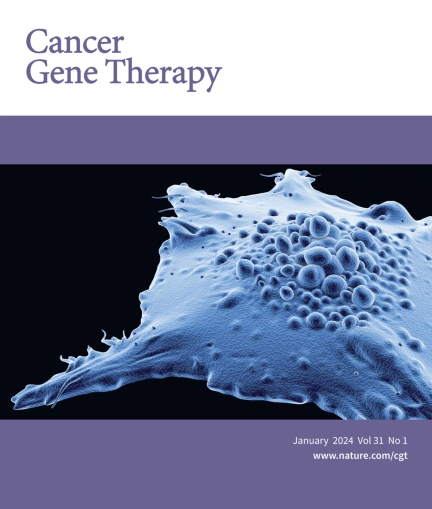N6-methyladenosine modification of RIMS binding protein 2 promotes head and neck squamous cell carcinoma proliferation and radiotherapy tolerance through endoplasmic reticulum stress
IF 4.8
3区 医学
Q1 BIOTECHNOLOGY & APPLIED MICROBIOLOGY
引用次数: 0
Abstract
Insulin-like growth factor binding protein 2 (IGF2BP2) fulfills a key role in the development of head and neck squamous cell carcinoma (HNSCC). Radiotherapy is an effective method to treat HNSCC; however, radiation resistance is the main reason for treatment failure. At present, the carcinogenic role of IGF2BP2 in terms of the proliferation of HNSCC and the radioresistance of its therapy remain poorly understood. In the present study, patients with HNSCC with higher IGF2BP2 expression levels were associated with shorter survival times. IGF2BP2 is significantly upregulated in HNSCC cells compared with irradiated cell. Based on functional studies, IGF2BP2 was found to promote HNSCC cell proliferation and tolerance to radiotherapy both in vitro and in vivo. In terms of the underlying mechanism, RIMS binding protein 2 (RIMBP2) was found to be highly expressed in HNSCC and to promote the proliferation of HNSCC and radiotherapy resistance. RIMBP2 was shown to be a direct target of IGF2BP2, activating endoplasmic reticulum stress in HNSCC. In addition, it has been demonstrated that IGF2BP2, as m6A reader, is able to promote RIMBP2 stability via binding to m6A sites in the RIMBP2-coding sequence region. Therefore, the present study has unveiled a potential mechanism via which IGF2BP2 promotes HNSCC development and radiotherapy resistance; moreover, from a therapeutic perspective, IGF2BP2 may serve as a potential therapeutic target and a valuable prognostic biomarker for patients with HNSCC who have developed tolerance towards radiotherapy.

n6 -甲基腺苷修饰RIMS结合蛋白2通过内质网应激促进头颈部鳞状细胞癌的增殖和放疗耐受。
胰岛素样生长因子结合蛋白2 (IGF2BP2)在头颈部鳞状细胞癌(HNSCC)的发展中起着关键作用。放疗是治疗鳞状细胞癌的有效方法;然而,耐辐射是治疗失败的主要原因。目前,IGF2BP2在HNSCC增殖中的致癌作用及其治疗的放射耐药性仍然知之甚少。在本研究中,IGF2BP2表达水平较高的HNSCC患者与较短的生存时间相关。与辐照细胞相比,IGF2BP2在HNSCC细胞中显著上调。通过功能研究发现,IGF2BP2在体外和体内均能促进HNSCC细胞增殖和对放疗的耐受。机制方面,研究发现RIMS结合蛋白2 (RIMBP2)在HNSCC中高表达,促进HNSCC的增殖和放疗抵抗。RIMBP2被证明是IGF2BP2的直接靶点,在HNSCC中激活内质网应激。此外,已有研究表明,IGF2BP2作为m6A读取器,能够通过结合RIMBP2编码序列区域的m6A位点来促进RIMBP2的稳定性。因此,本研究揭示了IGF2BP2促进HNSCC发展和放疗抵抗的潜在机制;此外,从治疗的角度来看,IGF2BP2可能作为一个潜在的治疗靶点和对放疗产生耐受性的HNSCC患者有价值的预后生物标志物。
本文章由计算机程序翻译,如有差异,请以英文原文为准。
求助全文
约1分钟内获得全文
求助全文
来源期刊

Cancer gene therapy
医学-生物工程与应用微生物
CiteScore
10.20
自引率
0.00%
发文量
150
审稿时长
4-8 weeks
期刊介绍:
Cancer Gene Therapy is the essential gene and cellular therapy resource for cancer researchers and clinicians, keeping readers up to date with the latest developments in gene and cellular therapies for cancer. The journal publishes original laboratory and clinical research papers, case reports and review articles. Publication topics include RNAi approaches, drug resistance, hematopoietic progenitor cell gene transfer, cancer stem cells, cellular therapies, homologous recombination, ribozyme technology, antisense technology, tumor immunotherapy and tumor suppressors, translational research, cancer therapy, gene delivery systems (viral and non-viral), anti-gene therapy (antisense, siRNA & ribozymes), apoptosis; mechanisms and therapies, vaccine development, immunology and immunotherapy, DNA synthesis and repair.
Cancer Gene Therapy publishes the results of laboratory investigations, preclinical studies, and clinical trials in the field of gene transfer/gene therapy and cellular therapies as applied to cancer research. Types of articles published include original research articles; case reports; brief communications; review articles in the main fields of drug resistance/sensitivity, gene therapy, cellular therapy, tumor suppressor and anti-oncogene therapy, cytokine/tumor immunotherapy, etc.; industry perspectives; and letters to the editor.
 求助内容:
求助内容: 应助结果提醒方式:
应助结果提醒方式:


